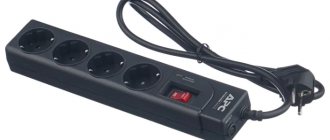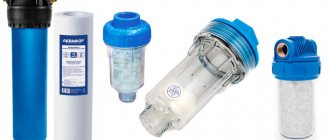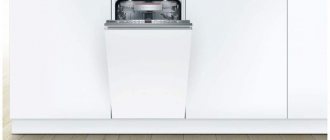We have all known for a long time that drinking water from the tap or from a well is a risky undertaking. And even not drinking, just using such water for technical needs can be dangerous - it can damage a gas boiler, plumbing, or shower.
In country life, high-quality water purification is of utmost importance, but there are no universal solutions: the filter must be selected depending on the composition and quality of the water. In this article, together with a specialist, we understand what a filter for a sink should be and how to choose it correctly.
Why do you need water analysis?
Residents of the countryside, as a rule, take water for life from a well or borehole. And if water from different surface sources is more or less similar, then water from two different wells will most likely be radically different. Moreover, water from a well may contain substances that are generally absent from surface sources. Therefore, the approach to its purification should be more serious, and first you need to find out what kind of water you have to deal with.
Roman Podobedov, Candidate of Chemical Sciences
The first thing you need to pay attention to is the total salt content. It can be either very low or sky-high. The norm for drinking water is 250-400 mg/l, the maximum permissible concentration is 1000 mg/l. In a well, this value can be exceeded several times. Three more parameters that require attention: hardness, iron and manganese content. When designing water treatment from a well, it is also necessary to measure the nitrate content; Exceeding the maximum permissible concentration for nitrates is a common problem. There may also be problems with excess fluoride content. In our work, we even encountered wells with arsenic, radon, nickel and other non-specific contaminants.
It is impossible to assess the composition of water visually and using the “pour water into a two-liter plastic bottle, shake and sniff” method - an analysis must be done before installing the filter.
As our expert says, without analysis, only a few of the most obvious problems can be identified. They are collected in a small cheat sheet.
| Problem | Signs |
| Presence of suspended particles. | Cloudy, opalescent water. |
| Rigidity. | Scale quickly forms on the kettle and a film forms on hot drinks. |
| Iron. | The water has a yellow coating and forms smudges on plumbing fixtures |
| Hydrogen sulfide. | Specific smell of rotten eggs. |
Roman Podobedov
The problem is that most particularly toxic substances (nitrates, fluorine, heavy metals) cannot be detected by eye or using improvised means. It is better to do a full water analysis.
Degrees of hardness-softness
Before answering the question of which filter to soften water, you need to understand what we will soften. The water classification includes:
- Soft. Very rare. Such aquifers are located very deep. Production wells are usually called artesian wells.
- Average. Typically found in homes with a central supply where softeners are installed on the water line.
- Typically found in homes with a central supply where softeners are installed on the water line.
- Super tough. Unfortunately, in most private homes with individual wells this is exactly the liquid. It may also be a consequence of the wrong choice of water field. This means an extremely unacceptable amount of impurities for most people.
Features of filters for washing
You can remove unwanted impurities from water at home by placing a three-stage drinking water purification system under the sink and connecting it to the pipe of the house water supply system (or the cold water main). You will need to install a separate faucet for purified water into the sink or countertop. Water, sequentially passing through all three stages of purification, gets rid of mechanical impurities, chlorine and organic and organochlorine impurities, heavy metals, undesirable tastes and unpleasant odors.
There are different options for completing the flow filter, and, depending on them, you can reduce the iron content and water hardness, as well as get rid of bacteria. Self-locking systems have now been developed that do not allow the filter elements to unscrew when the filter is even under strong pressure. Using the instructions, you can install such a filter yourself, in just half an hour.
Many people are bothered by the need to frequently change cartridges, but modern filters are designed in such a way that there are no problems with this - everything is done in one touch. There is no need to use a special key, wash the flasks and perform other tedious rituals.
Roman Podobedov
The easiest way to change cartridges is in three-stage cleaning systems - the operation takes 30 seconds and can be performed with one hand. The main thing is to remember to turn off the water before replacing! The frequency of replacing filter elements depends on the quality of the source water and the volume of its consumption (family size, whether they cook at home, whether they cook with filtered water). Typically, the frequency of replacing cartridges in washable filters is once every 6-12 months. But this can happen more often with high initial water hardness or a large family.
Choosing a softener - which company is better?
Most often, filter manufacturers of well-known brands are chosen. They have a large selection with different prices; such softeners are present in every city.
Most popular:
- Geyser;
- Barrier;
- Aquaphor;
- Atoll;
- New water.
The best softeners that can be installed under the kitchen sink are the three-stage Aquaphor filter, the reverse osmosis Geyser and the Barrier water purifier.
The best of the filter jugs: BRITA, Geyser and Barrier jugs.
Sorption filters and reverse osmosis: pros and cons
Flow-through filters for sinks are valued primarily for their speed of cleaning - consumers instantly receive clean water.
Roman Podobedov
In-line filters have two different cleaning principles. The first is sorption filters. They contain various sorbents (charcoal, ion exchange resin) that adsorb contaminants on their surface. The second type is reverse osmosis filters with a membrane whose pores allow only water molecules to pass through. On this membrane, the water flow is divided into two parts: 20-25% goes to the clean water tap, the rest goes to the drainage.
Which system is better? They both have strengths and weaknesses.
Roman Podobedov
The strength of reverse osmosis is that it can purify water of virtually any initial composition to the state of H2O. There are no alternatives to reverse osmosis if your water has very high iron levels (above 1.5 mg/l), nitrates or fluorides, risk of radioactivity or microbiological contamination, including viruses.
At the same time, according to the expert, this design also has a number of disadvantages:
- Water after reverse osmosis filters is absolutely “empty”; it does not contain not only harmful, but also useful substances. Drinking such water without additional mineralization for a long time is unsafe for health;
- Water consumption increases fourfold, since only one part of the water goes into the tap, and 3-4 parts into the drainage.
- To “push” water through the membrane, a pressure of at least three atmospheres is required. If there is no such pressure in the pipes, a pump and an electrical supply are necessary;
- Such systems are more expensive.
Unlike reverse osmosis filters, sorption filters are capable of purifying water only from those contaminants for which they contain a sorbent.
Roman Podobedov
This list includes all the contaminants characteristic of tap water: chlorine and its compounds, iron and heavy metals, odor, color, suspended solids, hardness up to 6 mEq/l. At the same time, such filters are cheaper and less sensitive to inlet water pressure and leave macronutrients that are necessary and beneficial for the body in the water.
How not to make a mistake and buy a fake? You need to pay attention to some characteristics:
- manufacturer's protective hologram;
- quality of devices (walls, gaskets, material)
- the manufacturer's website used (companies that have been on the market for a long time do not use a temporary or recently created website).
To sum up, when choosing a softener, you need to pay attention to the composition of the water and its intended use, so that the purchase is not thoughtless and costly. According to statistics, of all the regions of Russia, the softest water is in the Leningrad region and in the Republic of Karelia. In other regions, the water is medium or hard. Therefore, many people face the choice of a water softener. The health of the population depends on the quality of water consumed.
Is it possible to do without a filter?
Some people generally doubt the advisability of installing a filter: since the water from your own well is not suitable for drinking or cooking, it is better to take it in stores, from a spring, or bring it from friends. It will be more reliable and cheaper.
Kasap IvanForumHouse Member
Cheap filters will not clean the salts, but expensive ones will ruin them, and it’s not a fact that they will clean them properly. And their cleaning efficiency drops every day until the next cartridge replacement or addition of cleaning ingredients.
But, as our expert says, there is no need to completely remove salts from water; our body needs them. You need to remove harmful and toxic substances, and the filter copes with this task perfectly if:
- choose it correctly;
- change cartridges regularly (the cost of the kit will in any case be 100% lower than the cost of the corresponding volume of bottled water).
All well problems apply to springs; they may contain various non-specific contaminants that cannot be detected with the naked eye.
Roman Podobedov
If you regularly go to a spring, we recommend that you first take the analysis from it to the laboratory and check it for at least 15 parameters. The most important thing: microbiology and organics, hardness, iron, manganese, nitrates, fluorides. In our experience, the maximum permissible concentration for nitrates is exceeded in more than 60% of springs, and in regions with active agricultural activity - in 100%.
Liquid measurement
There are special rapid tests that give preliminary results. For a more accurate analysis of the situation, it is recommended to contact specialized companies.
An easy way to check
The most effective method to find out whether you need a filter to reduce water hardness is to carefully look at indirect signs. If plaque constantly forms on the tiles and plumbing fixtures, and the dishes remain stained after washing, then most likely you need special equipment. But if you are just planning to buy a home and do not have the opportunity to conduct such analytics, then we recommend that you first conduct an express test. To be completely sure, the next step should be to contact an accredited laboratory or a company affiliated with it.
How to choose filters taking into account the characteristics of water
When choosing a flow filter for your water, you need to clearly define what problem it should solve, and then be guided by the name or description of the filter.
Roman Podobedov
There is a filter that fights unpleasant odors and improves the color and smell of water. If you have problems with scale, there are also appropriate filters; there are designs that are used if “rusty water” has a metallic taste. If the source water is not chlorinated, it is recommended to use systems that contain a module with a special ultrafiltration membrane that provides protection against bacteria.
When choosing a filter, you need to focus on its ability to make your water drinkable, solve existing problems and not fall for the tricks of marketers.
110402FORUMHOUSE Member
How beautifully their manufacturers write about filters, it’s simply a masterpiece! As a complete sucker in this area, it’s hard for me to navigate.
Here are some things you should be wary of in filter descriptions:
Roman Podobedov
Among the tricks of marketers, I would include “perpetual motion machines” - filters that work for years without maintenance and at the same time clean “everything”; all kinds of water structurers (this has not been scientifically proven); water purification using magnetic fields, devices that make “living” and “dead” water - terms that are not fully defined by experts.
In addition, our expert advises buying filters from well-known brands in large chain stores: trusted manufacturers value their reputation and will not attribute properties to filters that they do not possess. And large chains carry out a fairly strict selection and testing of both manufacturers and their products before putting the filter on the shelf.
Roman Podobedov
And when purchasing, it is important to carefully review the information on the packaging and in the passport; the operating parameters of a given filter device are usually clearly indicated there.
Dangers of high salt concentrations
If a hard water filter is not installed, the consequences may be as follows:
- health problems, increased load on the kidneys;
- possible problems with teeth;
- the consumption of detergents (soap, powder, etc.) increases significantly;
- joints suffer from excessive salt deposits;
- clothes wear out much faster;
- it becomes difficult to care for your hair; washing and combing it is quite difficult;
- food has a strange taste;
- plumbing fixtures and tiles become covered with a layer of plaque almost immediately after cleaning;
- stains constantly form on dishes and kitchen utensils;
- household appliances break down.
Electromagnetic filter systems
Electromagnetic filters are devices in a plastic case with a built-in microprocessor. It emits electromagnetic waves of a certain frequency. The vibrations are transmitted through special wires, the ends of which are wound onto pipes in front of household appliances, protected from the effects of hard water.
Features of using the filter:
- Under its influence, the already deposited scale disintegrates over time.
- The cleaning device can be installed on a clean pipe made of any material.
- An electromagnetic filter for water of increased hardness is connected to the electrical network. During operation, it consumes a small amount of electricity. But the device does not require cartridge replacement.
Important! Under the influence of the filter, the physical and chemical properties of drinking water do not change, i.e. it contains exactly the same amount of impurities, but they cannot be deposited in the form of scale.
Electromagnetic devices are the most expensive of all, but also the most effective. They can also be used in conjunction with other filters.
USEFUL INFORMATION: How to replace a heated towel rail in the bathroom with your own hands: how to change it and how much the replacement costs
Ion exchange cleaning method: what is it good for?
Water hardness is a significant problem in the modern world. Hardness manifests itself as plaque on plumbing fixtures and white deposits on the surfaces of hot and cold plumbing fixtures. Chemical hardness is determined by the amount of calcium and magnesium bicarbonates that are in the water. The process of removing hardness salts using chemical softening - ion exchange resin - takes place in industrial water treatment, as well as in boreholes, wells and central water supply to houses.
There are three main methods of water softening:
Chemical softening - hot or cold liming
Membrane softening - nanofiltration
Cation exchange softening - using inorganic or synthetic ion exchangers.
The water softening system consists of the following components:
The filter housing is loaded with cation exchange resin, which softens the water.
Separate container for storing salt and for preparing the solution necessary for regeneration
Main control valve, which distributes water flows during operation and during regeneration
The key role is played by the ion exchange resin - cation exchangers, anion exchangers, ampholytes containing electrically conductive fragments are permanently attached to the polymer base.











